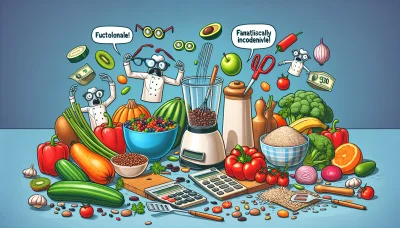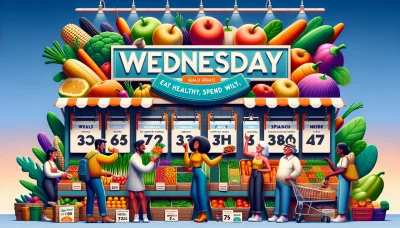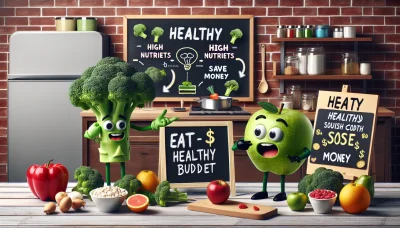Organizing with Jars and Containers on a Budget Quiz
Test Your Knowledge
Question of
Organizing with Jars and Containers on a Budget
Utilizing jars and containers for organizing food plays a pivotal role in maintaining a healthy eating routine while adhering to a budget. These storage solutions not only help in keeping your pantry and fridge neat but also extend the shelf life of various foods by ensuring they are properly sealed away from air and moisture. Moreover, by having a clear system of organization, individuals can easily keep track of their inventory, which aids in reducing food waste and unnecessary purchases. This approach to food storage is both cost-effective and environmentally friendly, making it an essential practice for anyone looking to eat healthily without overspending.
Benefits of Using Jars and Containers
- Helps in portion control, ensuring you eat the right amount of food.
- Facilitates meal planning and preparation, contributing to a healthier diet.
- Keeps food fresh longer, reducing waste and saving money.
- Allows for easy storage of bulk purchases, which are often cheaper and reduce packaging waste.
- Supports the preparation of balanced meals by storing a variety of nutrient-rich foods.
- Encourages the consumption of homemade meals over processed foods, enhancing overall health.
- Enables the easy transportation of meals, reducing the temptation to buy expensive and less healthy options when out.
How to Choose the Right Jars and Containers
When it comes to selecting the best jars and containers for food storage, two key factors to consider are affordability and suitability for healthy eating. It's essential to find solutions that not only fit your budget but also support your wellness goals. Look for containers that are made from safe, non-toxic materials like glass or BPA-free plastic, as these are better for storing food without compromising its quality. Additionally, consider the size and shape of the containers to ensure they meet your storage needs while maximizing space in your pantry or fridge. Opting for durable, reusable options can also contribute to both cost savings over time and a reduced environmental footprint, aligning with a healthy, sustainable lifestyle.
Creative Ways to Use Jars in Your Kitchen
- Store homemade dressings and sauces: Fill jars with your homemade dressings and sauces. Not only does this help reduce waste, but it also encourages you to eat healthier by knowing exactly what's in your condiments.
- Prep smoothie ingredients: Organize your smoothie ingredients in jars for each day of the week. This method not only saves time but ensures you're getting a healthy start to your day with minimal effort.
- Create overnight oats: Use jars to prepare overnight oats. This is a great way to have a quick, nutritious breakfast ready to go, especially on busy mornings.
- Assemble salad jars: Layer salads in jars for a healthy meal prep option. Starting with dressing at the bottom and ending with greens at the top keeps everything fresh until you're ready to eat.
- Store bulk pantry items: Fill jars with bulk pantry items like grains, nuts, and seeds. This organization technique helps you visually manage your ingredients and encourages incorporating these healthy items into your meals.
- Make jarred soups and stews: Prep and store portions of soups and stews in jars. This is perfect for controlling portions and ensuring you have a healthy, homemade meal ready on demand.
- Preserve fruits and vegetables: Use jars to preserve seasonal fruits and vegetables. This method allows you to enjoy your favorite produce year-round, adding a nutritional boost to your meals whenever you need it.
Storing Dry Goods with Jars and Containers
| Dry Good | Ideal Container Type | Tips for Maximizing Freshness and Nutritional Value |
|---|---|---|
| Flour | Airtight Glass or Plastic Containers | Keep in a cool, dark place and use within 8 months for best quality. |
| Rice | Airtight Containers or Vacuum-Sealed Bags | Store white rice in a cool, dark place for up to 2 years. Brown rice has a shorter shelf life of up to 6 months due to oils in the bran layer. |
| Pasta | Glass Jars or Plastic Containers | Keep in a dry place away from strong odors. Pasta can last up to 2 years if stored properly. |
| Beans | Airtight Containers or Mylar Bags with Oxygen Absorbers | Store in a cool, dark, and dry place. Dried beans can last up to 30 years under ideal conditions. |
| Sugar | Airtight Containers | Keep away from moisture to prevent clumping. White sugar can last indefinitely, while brown sugar has a shelf life of about 2 years. |
| Spices | Small Airtight Jars | Store in a cool, dark place. Ground spices should be used within 6 months for best flavor, while whole spices can last up to 1 year. |
| Coffee Beans | Airtight, Opaque Containers | Keep away from direct sunlight and moisture. For best flavor, use within 2 weeks of opening. |
Tips for Organizing Your Fridge and Pantry on a Budget
One effective and budget-friendly way to organize your fridge and pantry is by utilizing jars and containers. This method not only helps in keeping your food items neatly organized but also preserves their freshness longer. By categorizing items into different containers, you can easily maintain an inventory of what you have, reducing waste and unnecessary purchases. This approach supports a healthy eating lifestyle by making healthier food options more visible and accessible. Remember, clear containers allow for easy identification of contents, encouraging you to reach for those nutritious snacks and ingredients more often.
Maintaining and Cleaning Your Jars and Containers
To ensure your jars and containers remain in optimal condition for healthy food storage, it's essential to follow a few care and maintenance tips. First, always clean your containers thoroughly after each use with warm, soapy water. For stubborn stains or odors, a mixture of baking soda and vinegar can be very effective. Be sure to rinse them well to remove any soap residue. It's also important to dry your containers completely before storing them to prevent the growth of mold or mildew. For glass jars, avoid sudden temperature changes to prevent cracking. Regularly inspect your containers for any signs of damage, such as cracks or chips, and replace them if necessary to ensure the safety of your food storage. Following these simple guidelines will help keep your jars and containers clean, safe, and functional for years to come.












